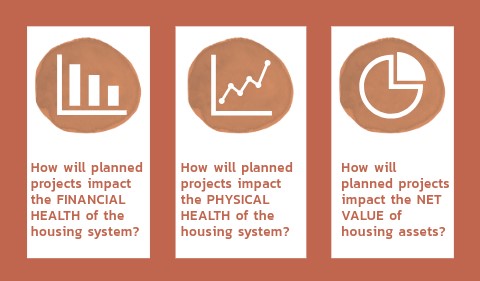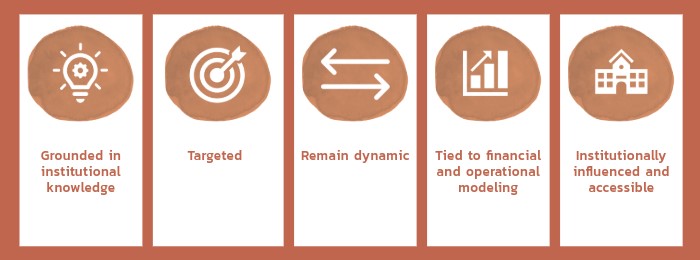Higher-education leaders have faced several years of market-driven concerns, procurement challenges, and shifting priorities. Institutions need more effective, predictive, and financially achievable processes to manage assets amid these (and other) context concerns. Universities must re-evaluate master planning initiatives, funding sources, aspiration achievability, and prioritization of project timelines.
Increasingly, institutions must weigh the value of re-investing in existing assets versus demolishing them and/or building new facilities. In these deliberations, leaders ask, how can we:
Using an institution’s housing portfolio as an example, the following walks through B&D’s approach to advising institutions seeking to answer the above questions.
The residential experience and housing portfolio significantly impact multiple facets of an institution, including campus recruitment, finances, operational requirements, total deferred maintenance, security, student experience and success outcomes, and capital planning. To capture the complexity of the impact housing has on an institution, B&D transforms and expands the original questions to develop these guiding questions:

Which leads us to t his comprehensive inquiry from which we build a hypothesis: “How can projects be most effectively planned, and resources most effectively deployed, to improve the system’s physical health and maintain financial health while advancing institutional aspirations?”
Thoroughly and honestly answering these questions positions the institution to identify and prioritize resource allocations to realize the greatest outcome-based impacts. However, to effectively chart an optimal course forward with unintended consequences mitigated, the institution must first understand their current position within their context.
The impact of an institution’s housing portfolio extends far beyond the residential life program. A housing officer will likely be the primary steward of the housing program, and responsible for strategic direction and execution of the initiatives. But to be most effective, support, collaboration, and expertise of their peers in finance, planning, facilities, enrollment, maintenance, dining, and student life are essential. For this reason, B&D recommends forming a core steering group to bring unique perspectives. The group, together, will uncover unintentional consequences as strategy is developed. The expanded expertise secures an optimized and cohesively committed path forward.
Given the highly integrated and impactful position residential portfolios hold within a university, collaboration across multiple stakeholders is essential to comprehensively address these inquiries. As residential life professionals and housing-adjacent disciplines begin to partner with B&D, comprehensive insights on long and short-term impacts emerge. These insights then guide, inform, and advance strategy development. The new awareness and ability to effectively communicate “across silos” provide significant value to the team and institution, not least of which are co-ownership of outcomes and a shared understanding of the foundational reasoning for proposed resource allocations, policy modifications, and the initiative’s schedule and sequencing.
B&D assists institutions to elevate their understanding of the broad connectivity and impact of program-specific decision-making on their system and/or campus. The process includes first understanding and then mapping the existing financial, physical, operational, and experiential context. Once the framework is mapped, the four views of current institutional conditions are overlaid with expanded insights from financial model projections, existing facility condition index reports and/or deferred maintenance logs, operational policies, portfolio tours, current strategic and master plans, proposed / scheduled capital planning efforts, and the like.
From this robust platform of context and expanded inquiries, B&D begins an iterative experience to guide institutions through hypothesis building, testing, and modifying to reach a path towards an achievable, impactful, and comprehensively healthy outcome.

The effectiveness of the iterative hypothesis development and testing process must be:
In summary, institutional asset management, regardless of asset-type, must not occur in a silo. Portfolios of assets–and their associated financial, physical, operational, and experiential components– impact, and are impacted by, the reality and intentionality of multiple adjacent and intersecting programs.
B&D’s approach to comprehensive asset management planning allows institutions to fully understand where there are available “levers-to-pull” and how they “move-the-needle” toward outcomes, across all impacted systems. We then communicate these relationships by way of graphic and overlayed views, models, and institutional scenario testing. While closely related to traditional master planning exercises, B&D’s approach to asset stewardship optimizes and communicates across the system, while creating co-ownership of decisions regarding the timing and prioritization of efforts, levels of investment, necessary resource allocation and policy modifications, and anticipated intensity of impacts on the student, faculty, and staff experience.
To discuss B&D’s dynamic and targeted approach to asset management planning and portfolio stewardship, please reach out to Rebecca Geraghty (rgeraghty@bdconnect.com), Carrie Rollman (crollman@bdconnect.com) or TJ Logan (tlogan@bdconnect.com). We would appreciate the opportunity to show you examples of past engagements, institutional perspectives and outcomes, and simply discuss your institution’s portfolio and current context.